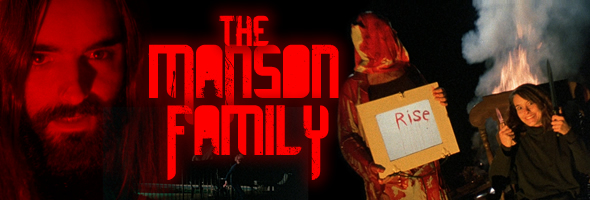
Color, 2003, 95m.
Directed by Jim Van Bebber
Starring Marcelo Games, Leslie Orr, Marc Pitman, Maureen Allisse, Jim Van Bebber, Tom Burns, Michelle Briggs, Carl Day
Severin (Blu-Ray & DVD) (US R0 HD/NTSC),
Dark Sky (DVD) (US R1 NTSC) / DD5.1
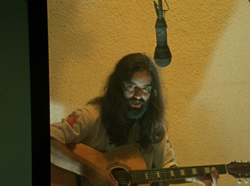 No other horror film has had a history as tortured as
No other horror film has had a history as tortured as 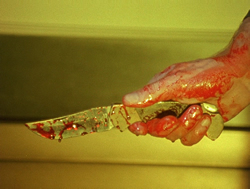 The Manson Family, director Jim Van Bebber's follow up to the 1987 cult favorite Deadbeat at Dawn. Van Bebber and his repertory company of players and crew members started working on the film in 1988 under the title Charlie's Family with shooting in full force by the early '90s, but financial difficulties forced it to shut down before completion. The ensuing years led to numerous false starts including a collapsed completion deal, not to mention other complications like the unavailability of actor Marcelo Games, who plays the infamous Charles Manson in the film. An incomplete rough cut screened at festivals kept word of mouth about it alive, and eventually funding was arranged to finish the film with the involvement of Blue Underground and David Gregory and Carl Daft (now at Severin Films). The film received a theatrical release in 2003, with multiple DVD editions from Dark Sky following soon after including an unrated version and a considerably shorter R-rated cut (which is best avoided). Almost a decade later, the Blu-Ray reissue from Severin Films revisits this turbulent project with substantial new extras and a new transfer showing off Van Bebber's film in the best light possible.
The Manson Family, director Jim Van Bebber's follow up to the 1987 cult favorite Deadbeat at Dawn. Van Bebber and his repertory company of players and crew members started working on the film in 1988 under the title Charlie's Family with shooting in full force by the early '90s, but financial difficulties forced it to shut down before completion. The ensuing years led to numerous false starts including a collapsed completion deal, not to mention other complications like the unavailability of actor Marcelo Games, who plays the infamous Charles Manson in the film. An incomplete rough cut screened at festivals kept word of mouth about it alive, and eventually funding was arranged to finish the film with the involvement of Blue Underground and David Gregory and Carl Daft (now at Severin Films). The film received a theatrical release in 2003, with multiple DVD editions from Dark Sky following soon after including an unrated version and a considerably shorter R-rated cut (which is best avoided). Almost a decade later, the Blu-Ray reissue from Severin Films revisits this turbulent project with substantial new extras and a new transfer showing off Van Bebber's film in the best light possible.
In 1996, a TV journalist named Jack Wilson (news anchor Day) works on an investigative piece about the members of Charles Manson's "family" of followers whose violent crimes marked the end of the peace and love movement of the 1960s. Interviews with the family members contrast with extended flashbacks to 1968 and 1969 as the family members settle in at the Spahn Ranch and indulge in rampant drug use, sex, and petty crime. Manson's failed singing career turns his mind control over the group in a darker direction, with family member Tex (Pitman) temporarily leaving while libertine Bobby (Van Bebber) agrees to lead a murderous order against a drug dealer Manson thinks is trying to do him harm. Meanwhile the female members -- Patty (Orr), Sadie (Allisse), and Leslie (Yates) -- have to prove their own allegiance in the most extreme ways possible. Adding contrast in 1996 is a modern day group of disaffected teens who consider themselves modern follows of Charlie, turning to violence and drugs as a 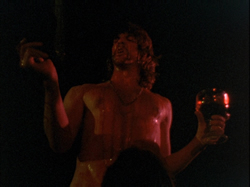 personal statement against the world around them.
personal statement against the world around them.
Almost an experimental film at times, The Manson Family is 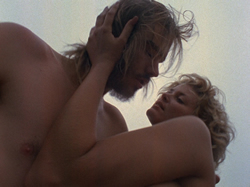 at its best when it focuses on the original family members and paints a persuasive picture of what life was like for these dropouts gone bad. The 16mm film stock is often intentionally distressed to give it a rough home movie look (created by running the film through kitty litter!), with Van Bebber's aggressive editing style and colorful visuals evoking a wide range of influences like Easy Rider, Kenneth Anger, and The Texas Chain Saw Massacre. The levels of sex and violence are very heavy throughout, not only in the two major murderous home invasions but in digressions like a nocturnal field orgy complete with blood rituals and a mock crucifixion of Manson himself. The major players, all of whom are recognizable from Van Bebber's prior film and various short projects, acquit themselves well and turn out to be truly fearless in front of the camera, and the unnerving soundtrack is an elaborate construction of original music by Skinny Puppy (for whom Van Bebber had directed a music video) and vintage recordings by Manson and even a few fleeting snippets of Jim Jones.
at its best when it focuses on the original family members and paints a persuasive picture of what life was like for these dropouts gone bad. The 16mm film stock is often intentionally distressed to give it a rough home movie look (created by running the film through kitty litter!), with Van Bebber's aggressive editing style and colorful visuals evoking a wide range of influences like Easy Rider, Kenneth Anger, and The Texas Chain Saw Massacre. The levels of sex and violence are very heavy throughout, not only in the two major murderous home invasions but in digressions like a nocturnal field orgy complete with blood rituals and a mock crucifixion of Manson himself. The major players, all of whom are recognizable from Van Bebber's prior film and various short projects, acquit themselves well and turn out to be truly fearless in front of the camera, and the unnerving soundtrack is an elaborate construction of original music by Skinny Puppy (for whom Van Bebber had directed a music video) and vintage recordings by Manson and even a few fleeting snippets of Jim Jones.
Unfortunately the film's history resulted in some imperfections as well, namely the awkward modern day Charlie followers who actually seem far more dated than the original 1960s ones. Their lack of a clear philosophy or purpose means they're just annoying, coming off more like rejects from Natural Born Killers than a logical progression of the cult of Manson. It's a shame they're the narrative device used to close out the film, which is easily its weakest moment.
The 16mm lensing means this film has almost always been screened at 1.33:1, which is how it's still presented on Severin's Blu-Ray. The quality is a significant jump over the SD version from several years ago, with much better rendering of the bright color schemes including several red-saturated shots that were previously hard to make out. Obviously some of the footage looks intentionally rough and gritty, but this looks much more like actual film and features a little more image information on the edges of the frame. The soundtrack can be played in a very unnerving DTS-HD Master Audio 5.1 mix or a standard Dolby Digital 2.0 version (the former is way more effective), while Van Bebber contributes an audio commentary in which he runs through the film's 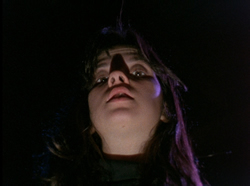 protracted history and colorful participants. He goes into detail about how proud he is of the film's accuracy with respect to the Manson family and explains why he had no interest in interviewing the real perpetrators; he's also apparently still quite the smoker as you can hear his lighter click several times during the movie.
protracted history and colorful participants. He goes into detail about how proud he is of the film's accuracy with respect to the Manson family and explains why he had no interest in interviewing the real perpetrators; he's also apparently still quite the smoker as you can hear his lighter click several times during the movie. 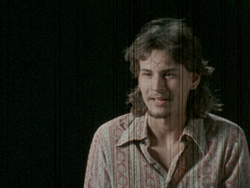
Carried over from the previous release is the excellent 77-minute documentary "The Van Bebber Family," directed by David Gregory, which features almost everyone involved (save for Games, for obvious reasons) talking about the production in extensive detail. The revelations here are very colorful to say the least, including discussions of real drug use on the set, the hiring of strippers for the field orgy (which in real life took place on a beach), the sticky consequences of using stage blood on naked bodies, and the emotional aftermath of the nastier developments in getting the film back off the ground. Van Bebber also explains in both the commentary and documentary how his short film "My Sweet Satan" was both a tool to raise production funds to finish the feature and the inspiration for the 1996 hooligan storyline, which was used late in the game to bring the narrative together.
Apart from the commentary, perhaps the coolest extra here is a brand new Van Bebber short film, "Gator Green," making its debut release here. It's a wild and intentionally goofy monster romp, a sort of 16-minute piece of bayou gothic involving abducted bar girls, wheelchair-bound war vets, and one very hungry gator. This is also presented in 1080p HD with a standard Dolby Digital stereo soundtrack. Musician Phil Anselmo (best known as lead singer of Pantera) appears for a new 10-minute interview in which he talks about his discovery of Van Bebber and how he became involved in contributing to the film's soundscape. Recurring from the previous DVD are the 73-minute "In the Belly of the Beast" doc looking at the Fantasia Film Festival at which the rough cut first appeared (with many other familiar genre names also popping up along with a look at the still maddeningly unreleased A Gun for Jennifer), along with a 10-minute vintage interview with Manson himself (sporting an ink swastika on his forehead, of course). Rounding out the disc are 14 minutes of very rough deleted scenes (shot on VHS from a projection on a wall) and five theatrical trailers (two from 2003, two from 2013, and one extended promo reel). Let's hope Van Bebber can get another film off the ground soon, but in the meantime, this expanded look at his most ambitious film to date does him proud.